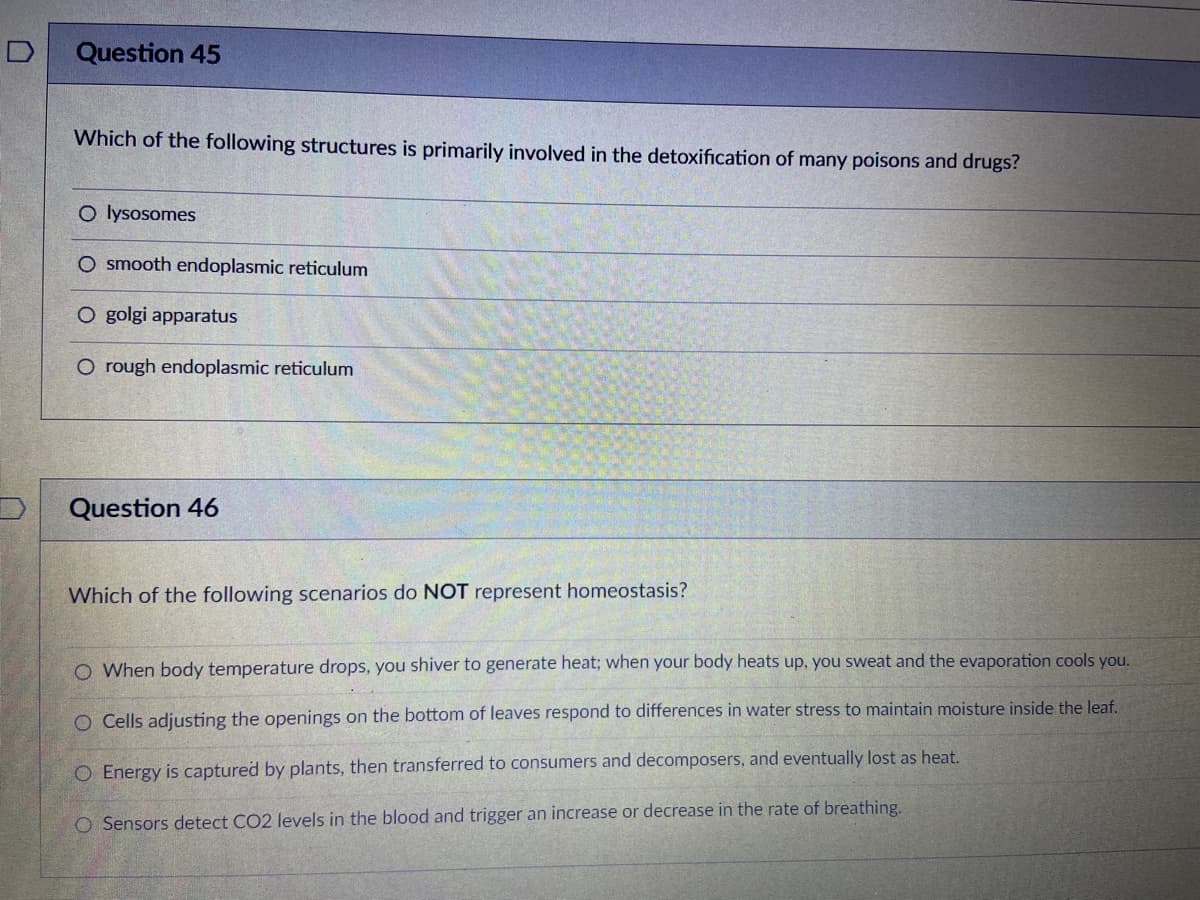Which of the following structures is primarily involved in the detoxification of many poisons and drugs? O lysosomes O smooth endoplasmic reticulum O golgi apparatus O rough endoplasmic reticulum Question 46 Which of the following scenarios do NOT represent homeostasis? O When body temperature drops, you shiver to generate heat; when your body heats up, you sweat and the evaporation cools O Cells adjusting the openings on the bottom of leaves respond to differences in water stress to maintain moisture inside the le O Energy is captured by plants, then transferred to consumers and decomposers, and eventually lost as heat. O Sensors detect CO2 levels in the blood and trigger an increase or decrease in the rate of breathing.
Which of the following structures is primarily involved in the detoxification of many poisons and drugs? O lysosomes O smooth endoplasmic reticulum O golgi apparatus O rough endoplasmic reticulum Question 46 Which of the following scenarios do NOT represent homeostasis? O When body temperature drops, you shiver to generate heat; when your body heats up, you sweat and the evaporation cools O Cells adjusting the openings on the bottom of leaves respond to differences in water stress to maintain moisture inside the le O Energy is captured by plants, then transferred to consumers and decomposers, and eventually lost as heat. O Sensors detect CO2 levels in the blood and trigger an increase or decrease in the rate of breathing.
Human Anatomy & Physiology (11th Edition)
11th Edition
ISBN:9780134580999
Author:Elaine N. Marieb, Katja N. Hoehn
Publisher:Elaine N. Marieb, Katja N. Hoehn
Chapter1: The Human Body: An Orientation
Section: Chapter Questions
Problem 1RQ: The correct sequence of levels forming the structural hierarchy is A. (a) organ, organ system,...
Related questions
Question
100%

Transcribed Image Text:Question 45
Which of the following structures is primarily involved in the detoxification of many poisons and drugs?
O lysosomes
O smooth endoplasmic reticulum
O golgi apparatus
O rough endoplasmic reticulum
Question 46
Which of the following scenarios do NOT represent homeostasis?
O When body temperature drops, you shiver to generate heat; when your body heats up, you sweat and the evaporation cools you.
O Cells adjusting the openings on the bottom of leaves respond to differences in water stress to maintain moisture inside the leaf.
O Energy is captured by plants, then transferred to consumers and decomposers, and eventually lost as heat.
O Sensors detect CO2 levels in the blood and trigger an increase or decrease in the rate of breathing.
Expert Solution
This question has been solved!
Explore an expertly crafted, step-by-step solution for a thorough understanding of key concepts.
Step by step
Solved in 2 steps

Knowledge Booster
Learn more about
Need a deep-dive on the concept behind this application? Look no further. Learn more about this topic, biology and related others by exploring similar questions and additional content below.Recommended textbooks for you

Human Anatomy & Physiology (11th Edition)
Biology
ISBN:
9780134580999
Author:
Elaine N. Marieb, Katja N. Hoehn
Publisher:
PEARSON

Biology 2e
Biology
ISBN:
9781947172517
Author:
Matthew Douglas, Jung Choi, Mary Ann Clark
Publisher:
OpenStax

Anatomy & Physiology
Biology
ISBN:
9781259398629
Author:
McKinley, Michael P., O'loughlin, Valerie Dean, Bidle, Theresa Stouter
Publisher:
Mcgraw Hill Education,

Human Anatomy & Physiology (11th Edition)
Biology
ISBN:
9780134580999
Author:
Elaine N. Marieb, Katja N. Hoehn
Publisher:
PEARSON

Biology 2e
Biology
ISBN:
9781947172517
Author:
Matthew Douglas, Jung Choi, Mary Ann Clark
Publisher:
OpenStax

Anatomy & Physiology
Biology
ISBN:
9781259398629
Author:
McKinley, Michael P., O'loughlin, Valerie Dean, Bidle, Theresa Stouter
Publisher:
Mcgraw Hill Education,

Molecular Biology of the Cell (Sixth Edition)
Biology
ISBN:
9780815344322
Author:
Bruce Alberts, Alexander D. Johnson, Julian Lewis, David Morgan, Martin Raff, Keith Roberts, Peter Walter
Publisher:
W. W. Norton & Company

Laboratory Manual For Human Anatomy & Physiology
Biology
ISBN:
9781260159363
Author:
Martin, Terry R., Prentice-craver, Cynthia
Publisher:
McGraw-Hill Publishing Co.

Inquiry Into Life (16th Edition)
Biology
ISBN:
9781260231700
Author:
Sylvia S. Mader, Michael Windelspecht
Publisher:
McGraw Hill Education